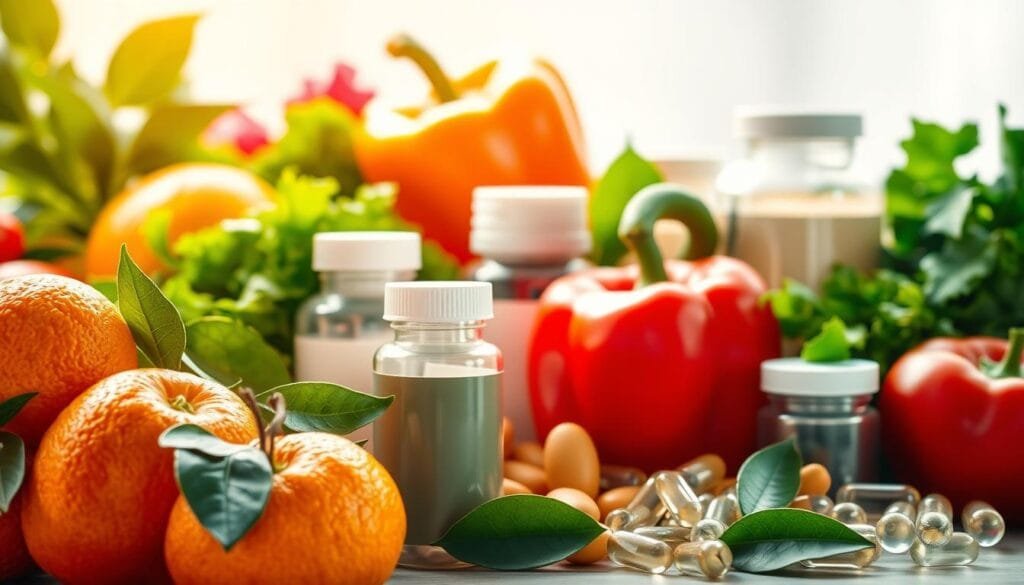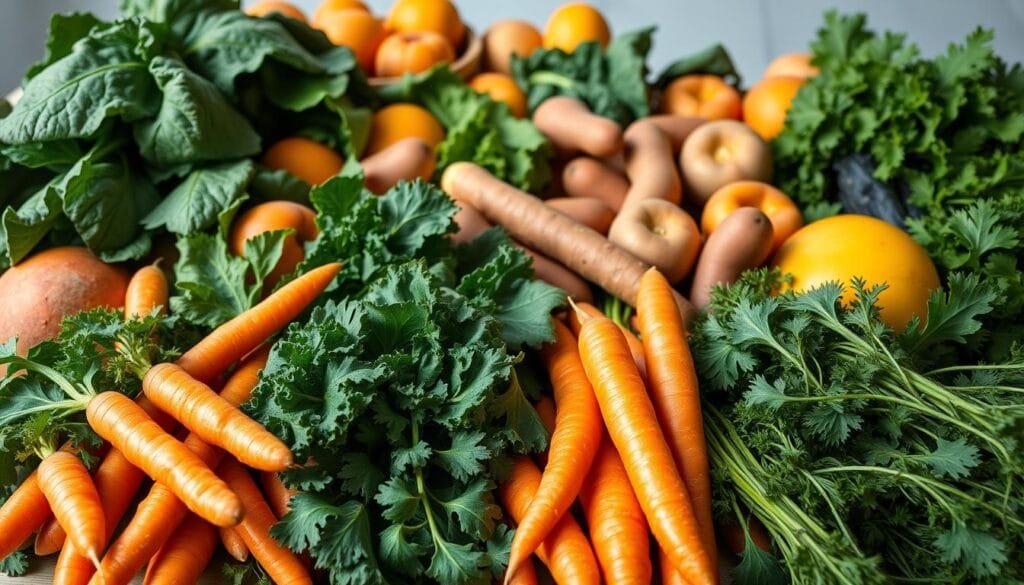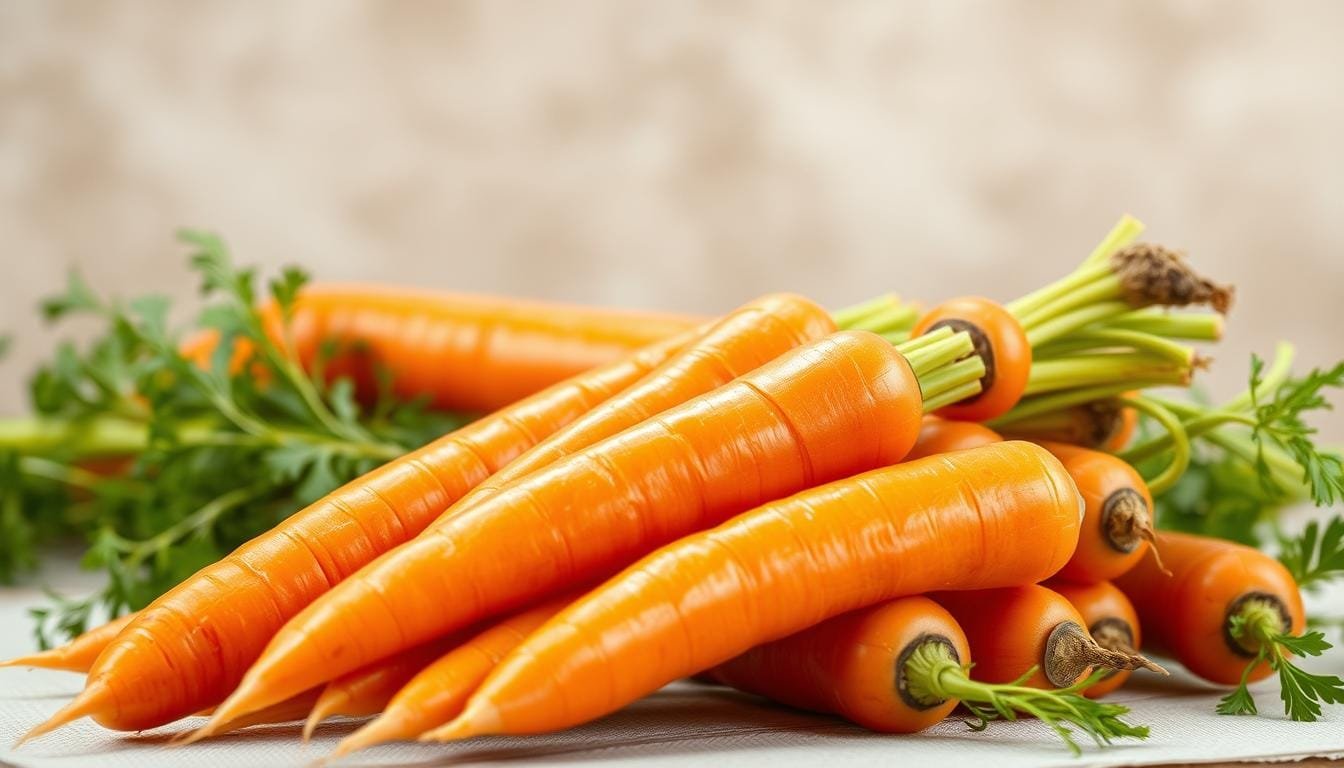Currently Empty: RM0.00
Did you know that nearly one in three people worldwide may not get enough vitamin A? This essential nutrient, often sourced from colorful fruits and vegetables, plays a crucial role in keeping eyes sharp and organs healthy. One of its key precursors? Beta carotene.
Found in carrots, sweet potatoes, and leafy greens, this compound converts to vitamin A in the body. Studies suggest it may reduce the risk of certain health issues while acting as a powerful antioxidant. But how much should one consume daily?
Though no official Recommended Dietary Allowance (RDA) exists for beta carotene, experts refer to vitamin A guidelines—ranging from 300 to 1300 mcg RAE based on age and gender. Understanding these values helps optimize nutrition for better vision, skin protection, and overall wellness.
Key Takeaways
- Beta carotene converts to vitamin A, supporting vision and organ function.
- No strict RDA exists, but vitamin A intake guides recommendations.
- Antioxidant properties help protect eyes and skin from damage.
- Food sources include carrots, spinach, and sweet potatoes.
- Balanced consumption may lower certain health risks.
What Is Beta Carotene and Why Does It Matter?
In 1831, a scientist first isolated an orange pigment from carrots. This discovery, made by Heinrich Wackenroder, revealed one of nature’s most versatile carotenoids—a group of pigments that give plants their vibrant colors. Today, we know this compound as a critical provitamin, meaning the body converts it into active vitamin A.
The Science Behind Beta Carotene
As a fat-soluble antioxidant, it neutralizes free radicals—unstable molecules that damage cells over time. Research links oxidative stress to aging and chronic diseases, making these protective effects vital for long-term health. Carotenoids like this one may even support immune function, adding another layer to their role in life.
How the Body Converts Beta Carotene to Vitamin A
The liver transforms it into retinol (active vitamin A) at a 12:1 ratio—12 mcg of the pigment yields 1 mcg of the vitamin. This slow conversion prevents toxicity, unlike preformed vitamin A from animal sources. Pairing carotenoid-rich foods with healthy fats boosts absorption, thanks to their fat-soluble nature.
Supplements lack the safety net of natural conversion. Evidence shows synthetic high-dose versions may pose risks for certain groups, while whole foods provide balanced provitamin A without overloading the body.
Health Benefits of Beta Carotene
Beyond adding color to your plate, this nutrient offers surprising protective effects. From shielding eyesight to defending against environmental damage, its impact spans multiple systems in the body.

Supports Eye Health and Reduces Macular Degeneration Risk
Age-related macular degeneration (AMD) affects millions globally. Studies show diets rich in carotenoids may lower this risk by 35%. Smokers who increased intake saw similar benefits, per a Korean study.
The mechanism? These pigments filter harmful blue light and neutralize oxidative stress in retinal tissues. Regular consumption builds long-term protection.
| Group | AMD Risk Reduction | Key Source |
|---|---|---|
| General Population | 35% | 2018 Cochrane Review |
| Smokers | 35% | Korean Cohort Study |
Boosts Cognitive Function and Memory
Long-term intake matters for brain health. Research suggests 18+ years of consistent consumption correlates with better memory retention. Antioxidant properties may slow cognitive decline by reducing inflammation in neural pathways.
“The cumulative effect of carotenoids on cognition underscores the importance of dietary patterns over quick fixes.”
Protects Skin from UV Damage
This nutrient acts as internal sunscreen. It accumulates in the skin, absorbing UV rays and minimizing sunburn cells. Regular intake may enhance skin resilience, though it’s no substitute for topical protection.
May Reduce Risk of Certain Cancers
Findings are mixed but promising. A 2017 study linked carotenoid-rich diets to lower lung cancer rates. However, synthetic supplements showed paradoxical effects in smokers—highlighting the superiority of whole foods.
Key contrasts:
- Dietary sources: Associated with 20–30% lower risk in non-smokers.
- Supplements: No significant benefit; potential harm for smokers.
Beta Carotene Daily Intake: Expert Recommendations
Retinol Activity Equivalents (RAE) simplify complex vitamin A calculations. Unlike preformed retinol, which the body uses directly, carotenoids like beta carotene convert at a 12:1 ratio. This means 12 mcg of the pigment equals 1 mcg RAE of active vitamin A.
Daily Allowances by Age and Gender
Guidelines vary based on life stages. The National Institutes of Health outlines these levels:
| Group | mcg RAE/Day |
|---|---|
| Men (19+) | 900 |
| Women (19+) | 700 |
| Pregnant Teens | 750 |
| Pregnant Adults | 770 |
| Lactating Women | 1,300 |
Special Considerations for Women
Pregnancy and lactation increase needs. Breastfeeding requires nearly double the intake to support infant development. Whole foods like sweet potatoes and kale meet these demands safely, unlike high-dose supplements.
“RAE values account for varying absorption rates, ensuring accurate nutrient tracking across diets.”
Why No Official RDA Exists
Unlike preformed vitamin A, provitamin A carotenoids have no upper limit (UL). The body regulates conversion, preventing toxicity. Key contrasts:
- Dietary sources: Safe even in large quantities.
- Supplementation: Synthetic forms may disrupt balance, especially for smokers.
This self-regulating mechanism makes precise RDAs unnecessary. Focus instead on colorful plates for optimal antioxidant benefits.
Top Food Sources of Beta Carotene
Nature’s brightest hues often signal the richest sources of this powerful antioxidant. Vibrant oranges, deep greens, and fiery reds in vegetables and fruits indicate high carotenoid content. For optimal nutrition, focus on these top picks.

Brightly Colored Vegetables
Carrots lead the pack with 8,279 mcg per 100g when cooked. Sweet potatoes follow closely, offering 9,406 mcg in the same serving. Other stars include:
- Pumpkin: 5,140 mcg (cooked)
- Red bell peppers: 1,620 mcg (raw)
- Butternut squash: 4,570 mcg (roasted)
In Malaysia, these vegetables are widely available at wet markets and supermarkets year-round.
Dark Leafy Greens
Spinach provides 5,626 mcg per 100g when steamed. Kale and Swiss chard are equally potent, with bioavailability increasing when paired with healthy fats like coconut oil—a staple in Malaysian cooking.
Cooking for Maximum Absorption
Heat breaks down cell walls, releasing more nutrients. Try these methods:
- Steaming carrots preserves 90% of their carotenoids.
- Sautéing spinach in olive oil boosts absorption by 30%.
- Roasting sweet potatoes caramelizes natural sugars, enhancing flavor and nutrient uptake.
“Pairing carotenoid-rich foods with fats transforms them into a bioavailable powerhouse.”
For a local twist, try stir-frying water spinach (kangkung) with garlic and sesame oil—a flavorful way to maximize absorption.
Risks and Considerations for Beta Carotene Intake
High-dose supplements may backfire for specific populations, research reveals. While whole foods provide safe antioxidants, synthetic forms can pose unexpected risks, especially for smokers. Understanding these nuances ensures smarter choices.
Why Smokers Should Avoid High-Dose Supplements
Studies link 20–30mg supplement doses to increased lung cancer rates among smokers. Unlike dietary sources, synthetic versions lack natural conversion safeguards. The effects are stark:
| Group | Risk Increase | Source |
|---|---|---|
| Smokers (supplements) | 18% higher lung cancer | ATBC Study |
| Non-smokers (diet) | 20–30% lower risk | NCCIH Data |
In Malaysia, where 21% of adults smoke, this risk is particularly relevant. Experts recommend prioritizing carrots or spinach over pills.
The Truth About Beta Carotene Toxicity
Carotenodermia—a harmless orange skin tint—often gets mistaken for toxicity. True overdose is rare with foods but possible with supplements. Key differences:
- Carotenodermia: Reversible, no health effects.
- Toxicity: Only from synthetic high doses (e.g., >30mg/day).
Supplements vs. Whole Foods: Which Is Better?
Natural sources outperform pills in bioavailability and safety. Cooking spinach in coconut oil (common in Malaysian cuisine) boosts absorption by 30%. Meanwhile, research shows synthetic antioxidants lack synergistic compounds found in vegetables.
“Whole foods provide a complex matrix of nutrients that isolated supplements cannot replicate.”
Cost-wise, local produce like sweet potatoes offers more value than pricey capsules. For lasting antioxidant benefits, colorful plates win.
Conclusion
Getting enough vitamin A precursors from natural sources is key for long-term health. Colorful fruits and vegetables provide safe, effective antioxidants without the risks of synthetic supplements.
For personalized guidance, Wellness Concept offers expert advice. Reach them via WhatsApp at +60123822655 during business hours:
• Monday-Friday: 9:30am–6:30pm
• Weekends: 10am–5pm (Malaysia time)
Their team helps create balanced meal plans rich in essential nutrients. Busy professionals appreciate their weekend availability for consultations.
Remember, a food-first approach delivers the best results. Contact Wellness Concept today for tailored nutrition strategies.
FAQ
How much beta carotene should someone take daily?
Experts recommend 3–6 mg (5,000–10,000 IU) per day from food sources like carrots, sweet potatoes, and leafy greens. Supplements should be used cautiously, especially for smokers.
Can eating too many carrots turn skin orange?
Yes, excessive intake of carotenoid-rich foods like carrots can cause a harmless condition called carotenemia, giving skin a yellow-orange tint.
Do supplements provide the same benefits as food sources?
Whole foods are preferred because they contain additional nutrients that enhance absorption. High-dose supplements may increase cancer risk in certain groups.
Why is beta carotene important for eye health?
It converts to vitamin A, which protects vision and reduces the risk of age-related macular degeneration. Foods like spinach and kale are excellent sources.
Are there risks for pregnant women taking beta carotene?
While food sources are safe, supplements should be discussed with a doctor. Excessive vitamin A from supplements can harm fetal development.
Does cooking affect beta carotene levels in vegetables?
Light cooking (steaming or roasting) can increase absorption. Pairing with healthy fats like olive oil further boosts nutrient uptake.



